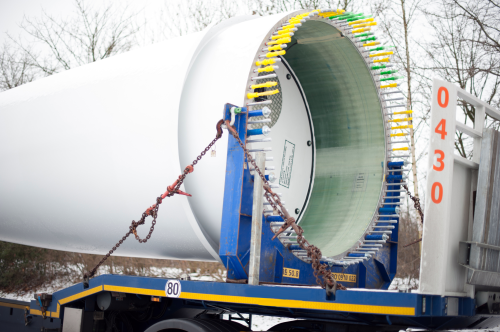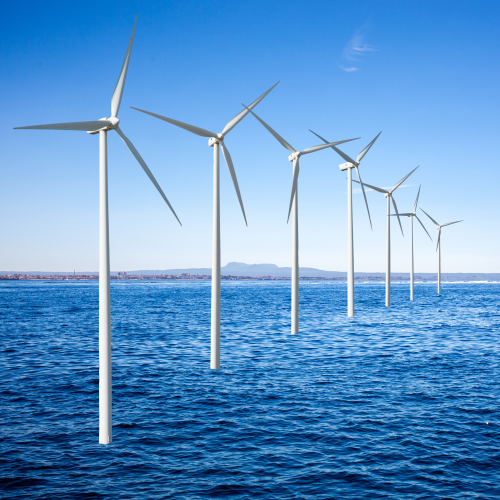

Megawind
In Europe a 40m high composite tower was built in the early years of this millenium as part of the European Megawind project. Project participants developed a concept for manufacturing towers on site using composite sandwich shells surrounding concrete or other core material. A key requirement of this, a European Union 5th Framework research programme, was to closely integrate the design, engineering and manufacture of such a tower. Design was conducted using state-of-the-art tools, validated in complex terrain situations. Emphasis was given to optimising the lamination process and to the secure joining of the various tower elements. The design and engineering team used numerical simulations to help verify the tower’s dynamic and structural performance. Major sub-assemblies were thoroughly tested before approval was given for final construction. Subsequently, the innovative tower itself, designed to support a 1.3MW turbine at a high-wind site in southern Europe, was subjected to extensive static and dynamic testing. A post-project report stated that whereas standard concrete and steel towers offer competitive prices at standard erection sites, this is not generally the case in isolated locations or in water depths of over 10 metres. Advanced composite structures could, it said, offer cheaper through-life solutions not only by reducing the costs of transporting and erecting wind generating superstructure but also of maintaining it in service - as well as by prolonging its service life and increasing the number of wind sites that could be commercially viable. These would include mountainous and other complex terrains onshore, plus offshore locations. For the latter, the chemical inertness of fibre reinforced plastics in salt water would be an added advantage.
Guyed composite
In the UK a Cambridge University study suggests that offshore wind farms could be twice as efficient as at present in terms of energy payback if a new type of turbine mounting infrastructure were to be adopted. Jim Platts of the University’s Institute for Manufacturing contends that turbine manufacturers could halve payback times if they were to build light composite towers and guy them with steel cables to provide additional support. Explaining the rationale, he says: “We urgently need to reduce the high levels of energy embedded in offshore wind turbines which make them both ineffective in energy payback and costly. We can do this fairly easily if we invest in more innovative methods for making and installing the towers and foundations that support them.” The study suggests that for a typical onshore turbine, a third of the energy used in manufacturing and installing it is accounted for by the tower and foundation. Offshore, where the towers required are taller and heavier, the more massive foundations need up to four times the amount of steel and concrete. Both steel and concrete are highly energy intensive to produce so the harvesting ratio - the ratio of the energy the turbine produces to the energy invested in the installation - drops from about 40:1 onshore to a much lower 15:1. Moreover, steel is prone to corrosion and fatigue. Overall, then, would another material system be preferable? According to Platts, the answer is yes. He adds: “We can use composites for towers just as we do for blades. These materials are lighter, stronger, corrosion free and more resilient than steel. Guying composite towers with steel cables, fixed to the sea bed by screw anchors, means that the towers can be much slimmer as the tent-like guyed shape distributes the loads more efficiently to the seabed. Similarly, the foundations required are much lighter.” The resulting reduction in the volume of steel and concrete needed means that a harvesting ratio of up to 32:1 can be achieved, the study concluded. Additionally, service lifetime could be extended from the 20 years that is expected at present to more like 60 years, declares Platts, who adds the general point: “Turbine manufacturers have driven advances in composites, producing materials with 95% of the performance of the high-cost composites used in aerospace at 5% of the cost. As a result, they already use ten times more composite materials than the car and aerospace industries combined. They now have an opportunity to go further.” Tentative steps have been taken. For instance, Finnish company Mervento is reported to have developed a design for a guyed turbine for use in the Baltic. More progress could be made if the understandable but conservative instincts of the civil engineering industry to stay exclusively with familiar tried and tested materials could be overcome. In deep water ‘floaters’, for instance, composite towers could reduce the buoyancy required to support the above-water structure, and hence the cost. Whether the system is semi-submersible, as proposed for a planned wind farm off Fukushima under the FORWARD project, or fully submersible held below the surface by tensioned cables, composites can reduce weight, logistical difficulty and cost. There is a substantial body of experience in composites application to civil infrastructure for engineers to draw on. For example, the use of fibrewrap techniques to strengthen concrete columns can significantly reduce the amount of concrete/cement required for a particular structural outcome. Or, at some future stage, it could prolong service life as part of a mid-life structural upgrade. More and more civil engineers are coming to value the low weight (150-900 g/sqm), low profile thickness, high E modulus (especially for carbon), excellent fatigue behaviour, high strength-to-weight and corrosion resistance advantages that engineered composites offer.
Advanced
Future innovative wind energy converters will also benefit from reinforced plastics, especially where these have complex shapes or other novel aspects. Two examples are the Invelox concept developed by Sheerwind Inc and a composite hybrid device proposed by businessman James Greeson. Invelox uses a directional wind capture system and the venturi effect to concentrate and accelerate the wind so that it impacts a ducted turbine with increased force. The system, which conceptually resembles a large vertical collecting funnel connected to a tapered duct that contains the venturi and turbine, has complex curvatures that immediately suggest a structural solution based on composites. The Invelox inventors say that bringing the airflow from the top of the tower (funnel) to ground level allows for greater power generation with much shorter turbine blades. The unit is about 50% shorter than traditional wind towers and uses a ground-based turbine with blades that are 84% smaller. Sheerwind claims that energy can be harvested from wind speeds as low as 2 mph and that this, together with the system’s smaller size, makes it suitable for a wider geographical range of use with minimum environmental impact. It can be used, it contends, in utility wind farm or micro-generation settings alike and, if appropriate, several funnels can be directed to a single generator. Results from tests with scale prototypes have reportedly exceeded expectations. Meanwhile, Georgia USA-based businessman James Greeson has proposed an intriguing palliative to the wind intermittency problem. The essence is that the cylindrical wind turbine tower is also a water tower, which is kept topped up with water pumped up by excess electricity that cannot be accepted to the grid at times of peak wind. Conversely, when the wind is too light for power generation, water can be gravity fed to a water generator at the base of the unit. The generator can be operated in ‘reverse mode’ as an electric motor to drive the water pump. The intended net effect of this combined wind turbine/pumped storage solution is a smoothing of the power available for supply to the grid. Success of the concept would rely strongly on composites. According to a Create the Future prize submission made by Greeson: “Traditionally wind turbine towers and water tanks are of steel or other metal construction. Few places in the world where wind turbines would be most effective have the industrial capacity to fabricate large steel assemblies, and their transportation to where they could be built and erected is prohibitively expensive or difficult. What is feasible to transport to remote areas are modular jig and lay-up machines, as well as the resins and composite materials with which to fabricated the tower structure. Either a pre-existing building of sufficient size or a prefabricated temporary structure is built to accommodate production. This approach provides jobs, income and new skills to areas where there are usually few if any of these.” Overall, the low weight and high structural properties of engineering composites, plus the valuable ability to manufacture or assemble composite elements on site, make these materials highly desirable for wind turbine towers and foundations. Whether the industry will continue to rely on the prevailing ‘Danish model’ of wind turbines or will adopt something altogether more futuristic, it seems clear that there is still plenty of untapped potential for composites to extend their contribution to the wind energy revolution.
Read Part 1 of this feature article
This article was published in the January/February 2014 issue of Reinforced Plastics magazine.
The digital edition of Reinforced Plastics is distributed free of charge to readers who meet our qualifying criteria. You can apply to receive your free copy by completing this short registration form.





